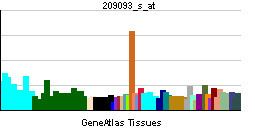Entrez 2629 | Ensembl n/a | |
 | ||
External IDs OMIM: 606463 MGI: 95665 HomoloGene: 68040 GeneCards: GBA | ||
β-Glucocerebrosidase (also called acid β-glucosidase, D-glucosyl-N-acylsphingosine glucohydrolase, or GCase) is an enzyme with glucosylceramidase activity (EC 3.2.1.45) that is needed to cleave, by hydrolysis, the beta-glucosidic linkage of the chemical glucocerebroside, an intermediate in glycolipid metabolism. It is localized in the lysosome and has a molecular weight of 59700 Daltons.
Contents
Clinical significance
Mutations in the glucocerebrosidase gene cause Gaucher's disease, a lysosomal storage disease characterized by an accumulation of glucocerebrosides. A related pseudogene is approximately 12 kb downstream of this gene on chromosome 1. Alternative splicing results in multiple transcript variants encoding the same protein.
Mutations in the glucocerebrosidase gene are also associated with Parkinson's disease.
Drugs
Alglucerase (Ceredase) was a version of glucocerebrosidase that was harvested from human placental tissue and then modified with enzymes. It was approved by the FDA in 1991 and has been withdrawn from the market due to the approval of similar drugs made with recombinant DNA technology instead of being harvested from tissue; drugs made recombinantly, since there is no concern about diseases being transmitted from the tissue used in harvesting, and are less expensive to manufacture.
Recombinant glucocerebrosidases used as drugs include:
